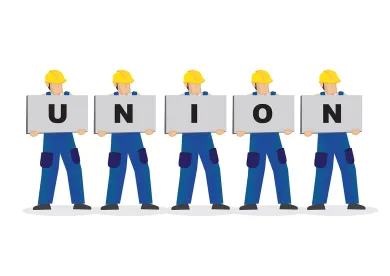The National Labor Relations Board (NLRB) has proposed rescinding portions of its 2020 union representation procedures on blocking charges, voluntary recognition bar, and construction industry collective bargaining relationships.
The Notice of Proposed Rulemaking (NPRM), published in the Federal Register on November 4, 2022, is another in a wave of changes to NLRB rules and procedures from the Biden Board. The NPRM follows the Board’s September 6, 2022, proposal to amend its joint-employer standard once again. Chairperson Lauren McFerran and Members Gwynne Wilcox and David Prouty voted to approve the latest proposed rule for publication, framing the proposal as the “Fair Choice and Employee Voice” rule. Members Marvin Kaplan and John Ring dissented.
Blocking Charges
Currently, if a party to an election (typically, a labor organization) files an unfair labor practice charge while an election is pending, the election is held as scheduled, irrespective of a pending charge. The Board impounds the ballots until finding the charge lacks merit or a determination is made that unlawful conduct occurred and warranted voiding the election (without counting the votes), followed by a rerun election.
Pursuant to the NPRM, if a party to an election files an unfair labor practice charge while an election petition is pending, a regional director may delay the election “if the conduct alleged threatens to interfere with employee free choice,” according to the NLRB’s press release. While the NLRB asserts the change will conserve Board resources by avoiding rerun elections, such blocked elections can result in election delays stretching over years. Delaying the vote also can mean the employees most involved in the organizing process may have moved on, losing the chance to vote.
Voluntary Recognition
Today, if a union proffers signed cards from a majority of the proposed bargaining unit, an employer can lawfully recognize the union. Whether and when employees may then seek a secret ballot election has been the subject of changing case law. In 2007, in Dana Corp., 351 NLRB 434, the Board ruled that employees (or a competing union) had a 45-day period following voluntary recognition to file an election petition. Four years later, in Lamons Gasket Company, 357 NLRB 739 (2011), the Board overruled Dana, implementing an elastic rule that allowed the recognized union a “reasonable amount of time” to negotiate a labor contract without disruption by an election petition. Under Lamons Gasket, if a contract was reached within the 45-day period, no petition could be filed during the term of the contract in most cases. This result had the potential effect of barring elections for up to four years.
In 2020, the Board effectively reversed Lamons Gasket, codifying the 45-day rule with the change framed as an effort to protect employee choice by facilitating secret ballot elections.
The NPRM would reinstate Lamons Gasket and, according to the NLRB, “eliminate the required notice-and-election procedure triggered by an employer’s voluntary recognition of a union based on a showing of majority support among employees.” This would prohibit some elections permitted under Lamons Gasket.
Construction Industry Recognition
Most industries are covered by Section 9(a) of the National Labor Relations Act (NLRA), which requires that union recognition be supported by certification following a secret ballot election or by voluntary recognition based on signatures from a majority of employees. However, exclusively in the construction industry, Section 8(f) of the NLRA allows an employer and a labor organization to establish a collective bargaining relationship without proof of majority support. Recognition granted under Section 8(f) does not bar a subsequently filed election petition.
However, in Staunton Fuel & Materials, Inc., 335 NLRB 717 (2001), the Board held the mere recitation (without a showing of evidence) in a collective bargaining agreement that the employer recognized the union based on a card majority would constitute proof of lawful — and binding — recognition. This created a bar to employee election petitions. Seeking to protect “the requirement of affirmative employee support,” in 2020 the Trump NLRB issued a NPRM mandating that Section 9(a) recognition in the construction industry (and its concomitant bar to elections) be based upon a contemporaneous showing of majority employee support.
The proposed rule would overturn Staunton Fuel, dispense with the requirement of majority employee support, and reinstate the possibility of binding recognition through collective bargaining agreement language. It also reimposes a six-month limitations period for challenging the employer’s recognition, thereby limiting employees’ ability to conduct an election or challenge union representation, even with a majority vote, based on the contractual recognition language.





 />i
/>i

